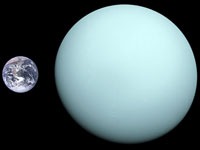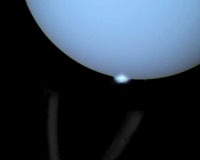In grade school, you most likely learned that Uranus is the seventh planet from the sun, the third largest in the Solar System by diameter and the fourth most massive. But there’s more to this big blue orb than that information. Check out some of the interesting facts about Uranus:
1. Uranus was the first planet to be officially discovered using technology.
Other planets were visible to the naked eye, so they were discovered before astronomical inventions were made. But Uranus was too dim for ancients to consider as a planet. The first sighting was recorded in 1690 by John Flamsteed, who classified it as a star from the constellation Tauri. Almost a century later, British astronomer William Herschel (pictured) accidentally discovered Uranus using a telescope in 1781. He was observing stars that were 10 times dimmer than those visible to the unaided eye and saw that Uranus actually followed a planetary orbit. Since then, it was confirmed that Uranus is a planet.
2. Uranus is the only planet in the Solar system that takes its name from Greek mythology.
Traditionally, planets were named after Roman gods, but Uranus got its name from the Greek god of the sky, Ouranos. The name Uranus was a Latinized version proposed by a German astronomer named Johann Bode.
But that wasn’t how Herschel wanted it to be. He originally named it after King George III of England as “Georgian Sidus,” which actually means “The Georgian Planet.” However, the astronomical community did not consider it as the name was not popular outside England.
3. Uranus orbits the sun sideways in a clockwise direction.
Unlike other planets which spin around the sun, Uranus “rolls” around it. The Earth’s axis is tilted 23.5 degrees away from the Sun, Mars’ is at 24 degrees, and Saturn’s is at 26.7 degrees, but Uranus is tipped over with an axial tilt of 98 degrees. Its north and south poles lie where most other planets have their equators.
Like Venus, Uranus rotate about its axis in a retrograde rotation, meaning it rotates clockwise, which is the opposite of other planets like Earth.
4. Uranus is the coldest planet in the Solar system.
Ever dreamed about traveling the surface of Uranus? Let it go because its freezing cold atmosphere will surely bother you anyway. Uranus is coined as the “ice giant,” because it has a minimum temperature of -371.56 degrees Fahrenheit, or −224 degrees Celsius. It has an icy blue exterior because its upper atmosphere is made up of a fluid mix of methane ice, ammonia ice, and water ice.
Its climate is extreme, too. If it’s not chilled and sunlight reaches its surface, the atmosphere gets heated up that can start spring storms.
 5. One year in Uranus is equivalent to 84 Earth years.
5. One year in Uranus is equivalent to 84 Earth years.
An average human might not even reach one year old in Uranus because a year on the planet lasts as long as 84 years on Earth. Uranus is about 2.8 billion kilometers away from the sun, so it would really take that long to make a complete orbit.
Because of the planet’s unusual tilt wherein one pole or the other is pointed towards the sun for a long time, one summer in Uranus will last for 42 Earth years, and this will be followed by winter for another 42 years.
6. Uranus has rings, too.
While not as spectacular as Saturn’s rings, Uranus’ ring system is the second most vivid in the Solar system. The planet has 13 distinct rings – 11 inner and two outers, with the brightest being the epsilon ring. The rings are not believed to have formed with Uranus because they are only a few kilometers wide.
7. Only one trip to Uranus has been made yet.
In 1986, NASA’s Voyager 2 spacecraft has flown past Uranus at a distance of around 81,500 km away from its surface. The mission has brought lots of information about the planet, including the very first close-up photos of the planet, its orbiting moons, and its ring system. No other spacecraft has approached Uranus as close as Voyager 2 yet.
8. Uranus has 27 moons.
Like the giant planets, Uranus has its own share of moons. So far, 27 have been observed orbiting around the planet. The largest moons include Miranda, Ariel, Umbriel, Oberon, and Titania. Among them, Titania is the biggest. Miranda has canyons, terraces and other odd-looking surface areas primarily made of ice.
The moons were named from characters from the works of William Shakespeare and Alexander Pope. Titania and Oberon were royalties in Shakespeare’s “The Midsummer Nights Dream,” and Miranda and Ariel were from his “The Tempest.” The names Ariel and Umbriel were from Pope’s “The Rape of the Lock.”
 9. Uranus is one of the least dense planets in the Solar system.
9. Uranus is one of the least dense planets in the Solar system.
Next, to Saturn, Uranus is the least dense planet. Its density is 1.23 grams per cubic centimeter. If it were placed in a pool around 60,000 km wide, the planet would float. Because of its low density, you can experience roughly 89% of the force of gravity, assuming you can stand on its cloud tops.
10. A chemical element is named after the planet.
Obviously, Uranium is the chemical element named after Uranus. In 1789, just a few years after the discovery of the planet, German chemist Martin Heinrich Klaproth named the chemical element after Uranus.

 5. One year in Uranus is equivalent to 84 Earth years.
5. One year in Uranus is equivalent to 84 Earth years. 9. Uranus is one of the least dense planets in the Solar system.
9. Uranus is one of the least dense planets in the Solar system.